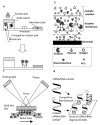Salivary biosensors for screening trauma-related psychopathology
- PMID: 20403559
- PMCID: PMC2858052
- DOI: 10.1016/j.coms.2010.01.004
Salivary biosensors for screening trauma-related psychopathology
Abstract
After facial trauma, a distinct subset of patients goes on to develop mental health problems including recalcitrant psychopathology. Early identification of maladaptive stress reactions provides opportunities for initiating preemptive mental health interventions and hinges on the surgeon's ability to differentiate between transient distress and precursors of recalcitrant psychiatric sequelae. The comprehensive care of injured patients will benefit greatly from objective adjuncts and decision-making tools to complement the clinical evaluation. This article addresses meeting the need for practical, standardized, and reliable screening strategies through promising developments in the use of stress response biomarkers and biosensing technology. The systematic interrogation of differentially expressed stress response biomarkers in saliva now permits rapid assessment of the psychopathogical response to the stressor. Quantitative, point-of-use measurements of the traumatic stress response will greatly improve the nosology of posttraumatic stress disorders and help advance the screening, diagnosis, treatment, and prevention of mental health consequences of violence and trauma.
Figures






Similar articles
-
Label-free, chemiresistor immunosensor for stress biomarker cortisol in saliva.Biosens Bioelectron. 2011 Jul 15;26(11):4382-6. doi: 10.1016/j.bios.2011.04.045. Epub 2011 May 31. Biosens Bioelectron. 2011. PMID: 21621995
-
Corticotropin-releasing hormone (CRH) in psychiatry: from stress to psychopathology.Ann Med. 2004;36(1):50-61. doi: 10.1080/07853890310017044. Ann Med. 2004. PMID: 15000347 Review.
-
Youth offspring of mothers with posttraumatic stress disorder have altered stress reactivity in response to a laboratory stressor.Psychoneuroendocrinology. 2015 Mar;53:170-8. doi: 10.1016/j.psyneuen.2015.01.001. Epub 2015 Jan 12. Psychoneuroendocrinology. 2015. PMID: 25622009 Free PMC article.
-
Impact of maternal trauma-related psychopathology and life stress on HPA axis stress response.Arch Womens Ment Health. 2022 Feb;25(1):121-128. doi: 10.1007/s00737-021-01169-6. Epub 2021 Aug 8. Arch Womens Ment Health. 2022. PMID: 34365527
-
[Posttraumatic stress disorder].Ryoikibetsu Shokogun Shirizu. 2003;(38):481-6. Ryoikibetsu Shokogun Shirizu. 2003. PMID: 12877031 Review. Japanese. No abstract available.
Cited by
-
Biosensors in clinical chemistry - 2011 update.Clin Chim Acta. 2011 Sep 18;412(19-20):1749-61. doi: 10.1016/j.cca.2011.06.025. Epub 2011 Jun 26. Clin Chim Acta. 2011. PMID: 21729694 Free PMC article. Review.
-
Advancing Point-of-Care (PoC) Testing Using Human Saliva as Liquid Biopsy.Diagnostics (Basel). 2017 Jul 4;7(3):39. doi: 10.3390/diagnostics7030039. Diagnostics (Basel). 2017. PMID: 28677648 Free PMC article. Review.
-
Salivary alpha-amylase and cortisol responsiveness following electrically stimulated physical stress in bipolar disorder patients.Neuropsychiatr Dis Treat. 2013;9:1899-905. doi: 10.2147/NDT.S48722. Epub 2013 Dec 6. Neuropsychiatr Dis Treat. 2013. PMID: 24353422 Free PMC article.
-
Saliva-based biosensors: noninvasive monitoring tool for clinical diagnostics.Biomed Res Int. 2014;2014:962903. doi: 10.1155/2014/962903. Epub 2014 Sep 8. Biomed Res Int. 2014. PMID: 25276835 Free PMC article. Review.
-
Mobile devices for the remote acquisition of physiological and behavioral biomarkers in psychiatric clinical research.J Psychiatr Res. 2017 Feb;85:1-14. doi: 10.1016/j.jpsychires.2016.10.019. Epub 2016 Oct 22. J Psychiatr Res. 2017. PMID: 27814455 Free PMC article. Review.
References
-
- Noy S, Levy R, Solomon Z. Mental health care in the Lebanon War, 1982. Isr J Med Sci. 1984;20:360–363. - PubMed
-
- Delahanty DL, Nugent NR. Predicting PTSD Prospectively Based on Prior Trauma History and Immediate Biological Responses. Annals of the New York Academy of Sciences. 2006;1071:27–40. - PubMed
-
- Rasmusson AM, Vythilingam M, Morgan CA. The neuroendocrinology of posttraumatic stress disorder: New directions. CNS Spectrosc. 2003;8:651–657. - PubMed
Publication types
MeSH terms
Substances
Grants and funding
LinkOut - more resources
Full Text Sources
Medical

